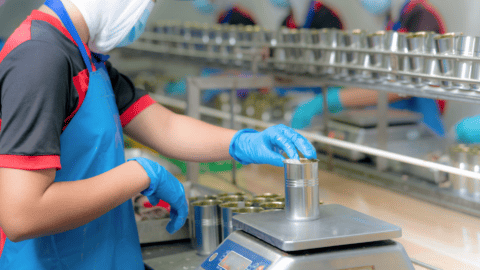The food processing industry is vast and varied, encompassing everything from meat and dairy processing to the packaging of fruits, vegetables, and grains. While these facilities are critical for food production, they are also environments where employees are exposed to a range of hazards. Ensuring the safety of these workers is paramount, not only for their well-being but also for maintaining productivity and compliance with regulatory standards.
Types of Food Processing Facilities
Each type of facility, whether it’s dealing with meat, dairy, fruits, vegetables, or grains, has specific processes and machinery. These differences in processes contribute to the variety of risks employees face daily.
Common Injuries in Food Processing Facilities
Injuries in these environments can range from minor cuts and burns to more severe incidents like amputations and repetitive strain injuries (RSIs). Slips, trips, and falls are also prevalent due to the often wet and slippery conditions of the work areas.
Preventive Measures and Safety Protocols
To mitigate these risks, facilities implement various safety measures, from machinery safeguards and floor safety improvements to chemical handling protocols and comprehensive training programs. The proper use of personal protective equipment (PPE) is also critical in protecting employees from harm.

Role of Management in Ensuring Safety
Management plays a crucial role in safety, responsible for implementing and enforcing safety protocols, conducting regular audits and inspections, and fostering a culture of safety through employee engagement and training.
Legal and Regulatory Framework
Regulations set forth by entities such as the Occupational Safety and Health Administration (OSHA) and the Food Safety Modernization Act (FSMA) provide guidelines and standards for workplace safety, which facilities must adhere to.
Impact of Injuries on Employees and Operations
Injuries not only have a significant impact on the affected employees, physically and psychologically, but they also affect the operations of the facility, leading to financial losses, decreased productivity, and lowered morale.
Most Common Food Processing Facility Employee Injuries
This section delves deeper into each of the most common injuries, exploring their causes, effects, and the specific measures that can be taken to prevent them.
Cuts and Lacerations
Causes: The primary cause of cuts and lacerations in food processing facilities is the frequent use of sharp tools and machinery, such as knives, slicers, and cutters. When employees handle these tools without proper safety equipment or training, or if the equipment is poorly maintained, the risk of cuts and lacerations increases significantly.
Prevention: Implementing comprehensive training programs on the correct handling of sharp tools and machinery is crucial. Regular maintenance and inspection of equipment to ensure sharp edges are safely contained can also reduce the risk. Providing employees with appropriate personal protective equipment (PPE), such as cut-resistant gloves, is another effective preventive measure.
Burns and Scalds
Causes: Employees in food processing facilities often work with hot surfaces, steam, and boiling liquids, leading to burns and scalds. These injuries can occur from accidental contact with hot machinery, splashback from hot liquids, or steam releases.
Prevention: Ensuring proper insulation of hot surfaces and implementing splash guards can significantly reduce these risks. Training employees on the safe operation of equipment that generates heat or steam and the use of PPE, such as heat-resistant gloves and aprons, is also vital.
Amputations
Causes: Amputations are a severe but unfortunately common injury in food processing plants, often resulting from improper use or maintenance of machinery. Employees might get limbs caught in unguarded moving parts or during the cleaning and maintenance of equipment.
Prevention: Machine guarding is one of the most effective ways to prevent amputations. Ensuring that all moving parts of machinery are properly guarded and that safety interlocks are in place and functioning can prevent access to dangerous areas. Regular training and strict protocols for machinery cleaning and maintenance are also essential.
Repetitive Strain Injuries (RSIs)
Causes: RSIs occur due to repetitive motions, awkward postures, and overuse of muscles and tendons. In food processing facilities, employees often perform repetitive tasks, such as cutting, packing, or assembly line work, which can lead to these injuries over time.
Prevention: Ergonomic assessments can identify risk factors for RSIs and help in redesigning tasks to reduce repetitive motions or awkward postures. Providing ergonomic tools and equipment, along with frequent breaks and job rotation, can also help minimize the risk.
Slips, Trips, and Falls
Causes: Wet and slippery floors are common in food processing facilities due to the use of liquids in processing and cleaning procedures. Obstacles in walkways and uneven floor surfaces also contribute to slips, trips, and falls.
Prevention: Maintaining clean and dry floors through regular cleaning and the use of anti-slip floor coatings can significantly reduce the risk of these accidents. Clear signage indicating wet floors, proper lighting, and keeping walkways free of obstacles are also crucial safety measures.
Future Trends in Safety and Injury Prevention
The future of safety in food processing facilities looks toward leveraging technological advancements, regulatory shifts, and the implementation of employee wellness programs to further reduce the risk of injuries.
Conclusion
Maintaining a safe work environment in food processing facilities requires continuous effort and commitment from both management and employees. By understanding the common risks and implementing effective safety measures, the industry can protect its workforce while ensuring the efficient production of food products.
Contact WorkSafe to find out how we can help your company today!
Working to keep you safe, healthy, and productive,

